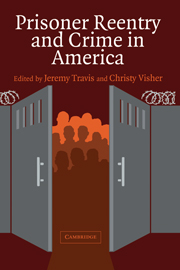Book contents
- Frontmatter
- Contents
- List of Contributors
- 1 INTRODUCTION
- 2 FROM CELL TO SOCIETY
- 3 REENTRY AS A TRANSIENT STATE BETWEEN LIBERTY AND RECOMMITMENT
- 4 THE CONTRIBUTION OF EX-PRISONERS TO CRIME RATES
- 5 DOES SUPERVISION MATTER?
- 6 THE IMPACT OF IMPRISONMENT ON THE DESISTANCE PROCESS
- 7 COMMUNITIES AND REENTRY
- 8 WORK AND FAMILY PERSPECTIVES ON REENTRY
- 9 CONSIDERING THE POLICY IMPLICATIONS
- Index
6 - THE IMPACT OF IMPRISONMENT ON THE DESISTANCE PROCESS
Published online by Cambridge University Press: 05 June 2012
- Frontmatter
- Contents
- List of Contributors
- 1 INTRODUCTION
- 2 FROM CELL TO SOCIETY
- 3 REENTRY AS A TRANSIENT STATE BETWEEN LIBERTY AND RECOMMITMENT
- 4 THE CONTRIBUTION OF EX-PRISONERS TO CRIME RATES
- 5 DOES SUPERVISION MATTER?
- 6 THE IMPACT OF IMPRISONMENT ON THE DESISTANCE PROCESS
- 7 COMMUNITIES AND REENTRY
- 8 WORK AND FAMILY PERSPECTIVES ON REENTRY
- 9 CONSIDERING THE POLICY IMPLICATIONS
- Index
Summary
Central to the promotion of public safety is an understanding of how and why offenders “go straight” or “desist from crime.” The study of desistance from crime has received an increasing amount of attention in recent years (see Giordano, Cernkovich, and Rudolph 2002; Laub and Sampson 2001), yet little of this work has focused on the role of the correctional system in this process. Indeed, something of a passive consensus has been reached in both the basic science on criminal careers and the more applied research on the effects of incarceration that the experience of imprisonment is largely irrelevant to the subsequent offending patterns of individuals. Farrall (1995) writes, “Most of the research suggests that desistance ‘occurs’ away from the criminal justice system. That is to say that very few people actually desist as a result of intervention on the part of the criminal justice system or its representatives” (p. 56).
Yet, surely an experience as profound as imprisonment has some impact (malignant or benign) on a person's life course trajectory. Most likely, these effects differ across individuals depending on a complicated mix of factors such as age, status, personality, previous life experiences, and the like. Prisons and the people who in habit them are complicated, multifaceted, and diverse. Presumably, the experience of imprisonment varies across institutions, individuals, time, and place (see, e.g., Walters, 2003). All of the above make the question we will address in this chapter – how imprisonment affects the likelihood of desistance from crime – more than a little challenging to answer.
- Type
- Chapter
- Information
- Prisoner Reentry and Crime in America , pp. 139 - 178Publisher: Cambridge University PressPrint publication year: 2005
- 80
- Cited by

